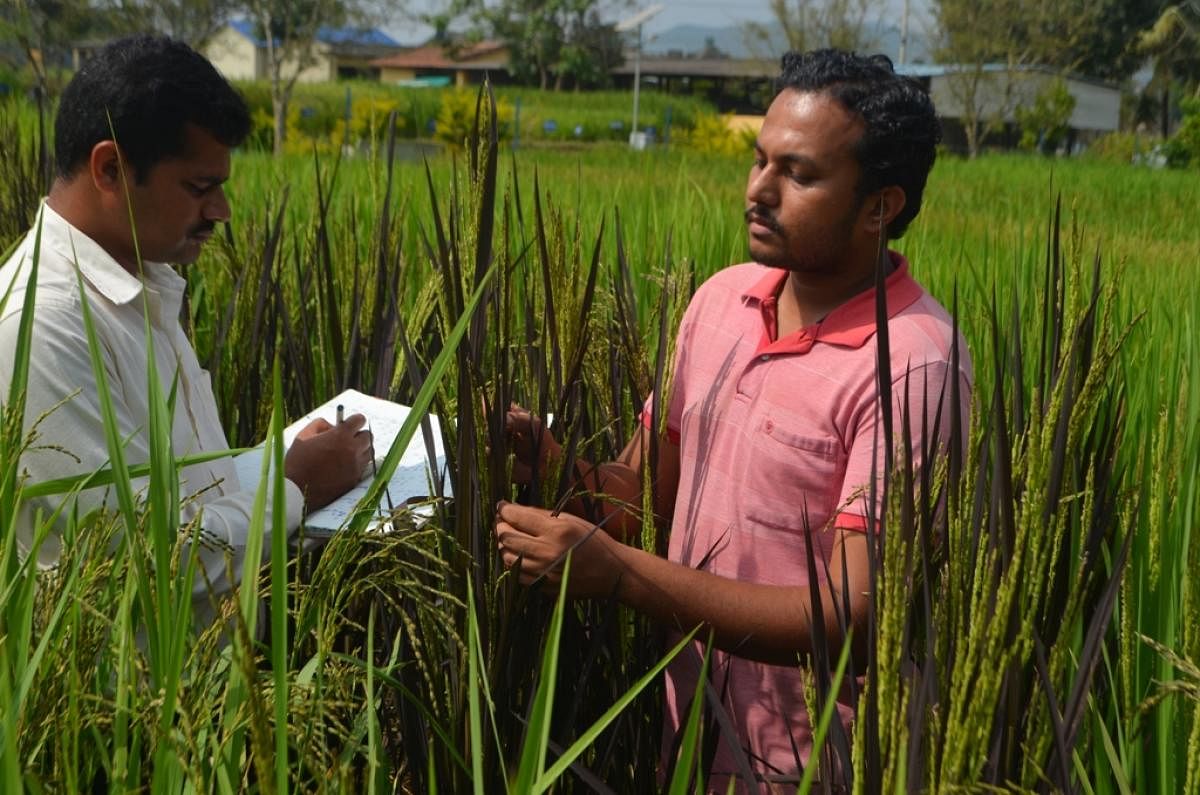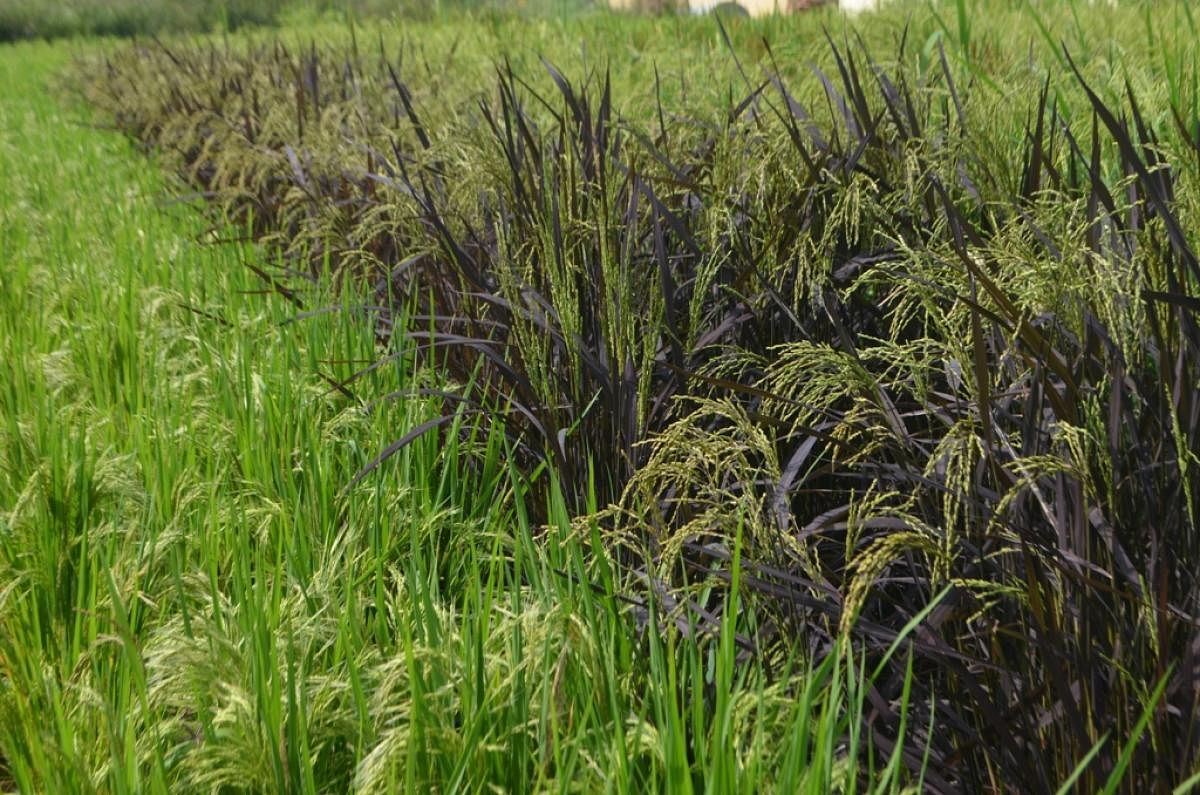

Three decades into the revival of heirloom seeds, farmers across the state have preserved hundreds of paddy varieties, not only those indigenous but also those from other parts of the country and the world. As a result, the paddy fields of these custodians turn into a mosaic of colours and shapes during the harvest season which falls in November and December.
Of them, some colours, mainly black, stand out.
Consider Shivamogga. Many stretches of paddy fields in the district look black these days, thanks to the renaissance of black rice brought about by the Organic Farming Research Centre (OFRC), Shivamogga.
The centre is popularising heritage varieties among farmers along with research in the field.
Growing black rice, which has its roots in north-east India, is becoming popular in other regions as well, among farmers. It’s extensively grown in Odisha, West Bengal and Jharkhand and commonly consumed in Manipur.
This variety is learnt to have emerged out of imperial China. Popular history says only royal families consumed it.
Standing out
Prominent varieties of black paddy include Kari Munduga, Karingellu, Kari Jeddu and Navaradanta. Rice of these varieties weighs more. The husk is black, while the rice is red.
The husk of Kari Gajovoli, Kagisale and Kalajeeradanta are dark black, while the rice is white. These are aromatic.
This year, OFRC had prepared 248 plots of native paddy. Out of them, 20 varieties are black rice. The leaves of Dambarasali and Nazarabad are dark brown, like the flame on the rice field. Grain is in golden colour. This colour variation helps the paddy art.
Gandu Bhatta, a crop that resembles paddy, is a weed that grows in paddy fields and affects the crop. It takes farmers for a ride as it’s difficult to notice its existence till the paddy flowers.
Farmers in and around Sorab and Sagar follow a method to address this challenge. They grow Nyaremida, a variety of black rice. Since the colour of Gandu Bhatta is green and that of Nyaremida black, it becomes easy for farmers to identify and clear the Gandu Bhatta. The peculiarity of some varieties of black rice is that its roots, stems, leaves and panicles are all black in colour. Chak-hao in Manipur, Karapu Kavani in Tamil Nadu, Kalabhat in Maharashtra, Kalabhati in Odisha and Burma Black in northeast states are other prominent varieties of black rice.
All these varieties are available at paddy plots of OFRC.
The husk of Kalabati variety is purple, while the rice is black. Leaves and husks of Chak-hao are light black in colour. Rice of this variety is dark black in colour.Plants of Burma Black variety look green, while the rice is black. This variety of rice is sticky and aromatic.
Sweet dishes prepared using these varieties are known for their taste. There is no need to add cardamom to the dishes as most of these varieties are aromatic.
Win-win
According to Somesh, the chief executive officer of Sahaja Organics, a farmer producer company, there is a demand for black rice. One kilogram of black rice is sold for Rs 200 in Bengaluru’s organic outlets. In turn, farmers get a good price.
Krishna, an organic farmer in Mandya, has been marketing black rice without any glitch for the past few years. In Belagavi, Shankar Langati has been cultivating black varieties for the past two decades.
He sows seeds in such a manner that the field looks artistic when the crop grows. The black rice has many nutritional, medicinal properties. Researches have found that black rice contains more Vitamin B and E, niacin, iron, calcium, magnesium and zinc. It has a high amount of dietary fibre and the grains have a nutty taste.
It actives detoxifying enzymes. Most of the black varieties are used to make sweet dishes.
It is known to kill cancerous cells (apoptosis), has anti-inflammatory properties and anti-angiogenesis effects. According to Pradeep S, head of the OFRC, this variety gets its dark black or purplish colour because it is rich in anthocyanins, which are powerful antioxidants. “Because of their medicinal properties, there is a good demand for these varieties. Hence, there is a special focus on research on black varieties,” he said.
Kalabati, a variety of black rice, is predominantly grown in Odisha. It grows up to 5 to 6.5 feet in height and changes its colour every week.
Young scientists Ullas M Y and Keerthan, who are working on the conservation and propagation of these unique varieties, stress that the centre encourages farmers to experiment with these varieties by distributing seeds and providing necessary guidance.
M K Naik, vice chancellor, University of Agricultural and Horticultural Sciences, Shivamogga, said, “Black varieties grown in flood-prone and drought-prone regions are special. The university has taken up characterisation and nutritional analysis of these special varieties.”
The centre also houses a paddy museum where heritage paddy varieties are displayed with information about their origin and cultivation.
Cooking tips
Black rice is generally sticky in nature and good for making payasam
Black Rice Payasam Recipe
Ingredients
1 cup black rice
1.2 cup jaggery powder/jaggery
2 teaspoons ghee ( optional)
Preparation
Wash the rice and soak it overnight ( 10-12 hours). Cook the rice with water (1:3 ) in a pressure cooker. Take the rice out of the cooker and add the jaggery/jaggery powder and slowly cook in an open vessel, till the jaggery and rice mix well. When it’s sticky in consistency and shiny in appearance, it will retain a chewy texture.